Biology MCQs with answers for NEET Sexually Transmitted Infections (STIs)
Question 1. Disease transmitted from an infected person during unprotected vaginal, anal and oral contact is called
- Sexually transmitted disease
- Waterborne disease
- Pathogenic disease
- Communicable disease
Answer: 1. Sexually transmitted disease
Sexually transmitted diseases transmit through body fluid discharge like vaginal secretion, semen, etc., during unprotected intercourse.
Read And Learn More: NEET Biology Multiple Choice Question And Answers
Question 2. Identify the correct match.
- STDs – Sexually Transmitted Diseases
- VD – Venereal Disease
- RTI – Reproductive Tract Infection
Choose the correct answer
- 1 and 2
- 2 and 4
- 1 and 3
- 1, 2 and 3
Answer: 4. 1, 2 and 3
All the given matches are correct. Thus, option (4) is correct.
“neetprep reproductive health “
Question 3. Incidents of STD are usually very high among people belonging to the age group of
- 15 to 35 years
- 15 to 30 years
- 15 to 24 years
- 15 to 45 years
Answer: 3. 15 to 24 years
Incidents of STDs are very high in the population of 15 to 24 years of age group due to active sexual interests.
NEET Biology sexually transmitted infections MCQs with answers
Question 4. Early stage symptoms of most STDs include
- Itching
- Fluid discharge
- Slight pain
- Swelling
Choose the correct option.
- 1, 2 and 4
- 1, 2 and 3
- 1, 3 and 4
- 1, 2, 3 and 4
Answer: 4. 1, 2, 3 and 4
All given symptoms, i.e. swelling, itching, fluid discharge, slight pain etc are the early symptoms of most STDs. Thus, option (d) is correct.
Biology MCQs with answers for NEET
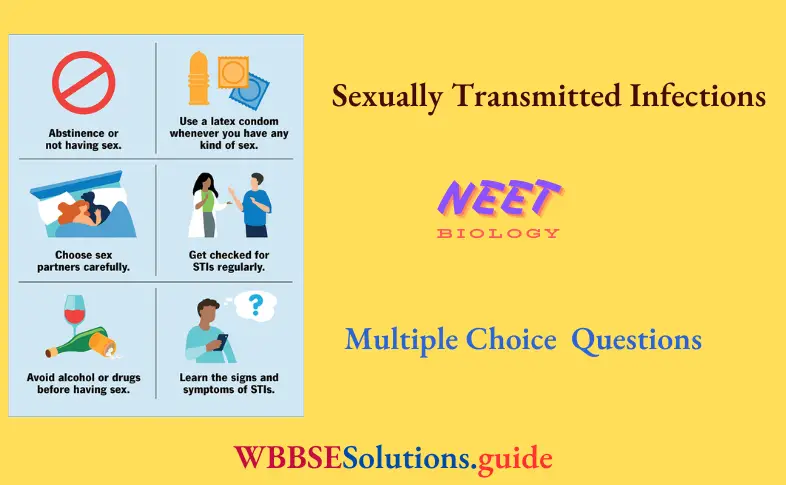
Sexually transmitted diseases (STDs) multiple choice questions for NEET
Question 5. Which of the following statements is/are incorrect about STDs?
- STDs are called silent infection
- STDs lead to changing pattern of sexual behaviour
- Abstinence results into STD infection
- Pathogens of STDs develop resistance to antibiotics
Answer: 3. Abstinence results into STD infection
Statement in option 3 is incorrect and can be corrected as Abstinence means abstain from sexual intercourse, thus it can help in preventing STD infections. Rest statements are correct about STDs
“mcq reproductive health “
Question 6. Which one of the following statements is correct regarding Sexually Transmitted Diseases (STDs)?
- A person may contact syphilis by sharing food with person suffering from disease
- Haemophilia is one of the STDs
- Genital herpes and sickle-cell anaemia both are STDs
- The chance of a 5-year-old boy contacting a STD is rare
Answer: 4. The chance of a 5-year-old boy contacting a STD is rare
Statement in option 4 is correct. The chance ofa 5- old -year- boy contacting STD is very rare, since he is unlikely to have sex at this age. Rest statements are incorrect and can be corrected as
- A person may contact syphilis by direct contact with a syphilitic sore, known as chancre.
- Haemophilia is a X-linked recessive disorder.
- Genital herpes is sexually transmitted infection, but sickle-cell anaemia is an inherited group of disorder.
Question 7. Later stage complications of STDs are
- Pelvic inflammation disease
- Abortion
- Still birth
- Ectopic pregnancies
- Infertility
- Cancer
Choose the option containing correct combinations.
- 1, 2, 3, 4 and 5
- 1, 2, 3. 5 and 6
- 1, 3, 4, 5 and 6
- 1, 2,3, 4, 5 and 6
Answer: 4. 1, 2,3, 4, 5 and 6
Consequences of delayed treatment of STDs are threatening. If proper and timely treatment is not given, STDs may lead to complications such as Pelvic Inflammatory Disease (PID), abortions, still birth, ectopic pregnancies, infertility or even cancer of the reproductive tract. Thus, option (4) is correct.
Biology MCQs with answers for NEET
Question 8. Select the option including all sexually transmitted diseases.
- Gonorrhoea, malaria, genital herpes
- AIDS, malaria, filaria
- Cancer, AIDS, syphilis
- Gonorrhoea, syphilis, genital herpes
Answer: 4. Gonorrhoea, syphilis, genital herpes
Gonorrhoea, syphilis and genital herpes, all are sexually transmitted diseases.
- Gonorrhoea is caused by a bacterium, Neisseria gonorrhoeae. It is a Sexually Transmitted Disease (STD) that can infect both men and women.
- It can cause infections in the genitals, rectum and throat. Syphilis is caused by a bacterium, Treponema pallidum. It starts as painless sore, typically on the genitals, rectum or mouth.
- Genital herpes is caused by a virus type-II herpes simplex virus. It causes herpetic sores or painful bilsters (fluid-filled bumps) that can break open and ooze fluid.
“questions about reproductive health “
Question 9. STDs caused by viruses are
- AIDS
- Hepatitis-B
- Genital herpes
- Chancroid
Choose the correct answer
- 1, 2, 3 and 4
- 1 and 3
- 2, 3 and 4
- 1 and 2
Answer: 1. 1, 2, 3 and 4
All the given STDs are caused by viruses. Viral STDs are as follows:
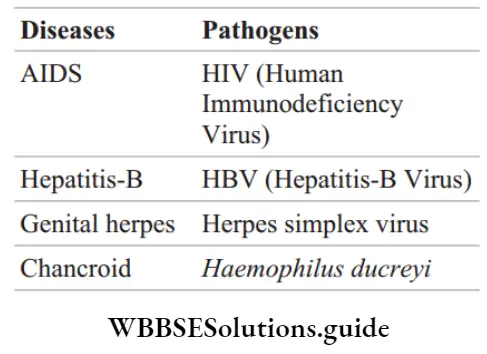
Important STI and STD questions for NEET Biology exam
Question 10. All the listed pathogens cause STD, except
- Bacteria
- Parasite
- Fungi
- Virus
Answer: 3. Fungi
STDs are caused by bacteria parasites and viruses. Fungi do not cause STDs.
Biology MCQs with answers for NEET
Question 11. A bacterial infection that cause genital inflammation and discharge is
- Treponema
- Syphilis
- Urethritis
- Gonorrhoea
Answer: 4. Gonorrhoea
- Gonorrhoea is a bacterial infection that may result in yellowish discharge from the genitals accompanied by itching and burning.
- Other options are explained as Treponema is responsible for diseases such as syphilis, bejel and yaws. Urethritis is the inflammation of urethra.
Question 12. Common STD in India is
- Syphilis
- Gonorrhoea
- AIDS
- Herpes
Answer: 2. Gonorrhoea
Gonorrhoea is the common sexually transmitted disease in India.
Question 13. It is a disease which mainly affects mucous membrane of urinogenital tract. In males, burning feeling on passing urine, after a yellow discharge occurs, that is accompanied by fever, headache and feeling of illness. The STD is
- Syphilis
- Gonorrhoea
- AIDS
- None of these
Answer: 2. Gonorrhoea
Gonorrhoea results in inflammed mucous membrane of urinogenital tract. Due to this, person experience burning senstation while urinating yellow discharge, fever, headache, etc.
Biology MCQ For NEET With Answers
Question 14. The sexually transmitted disease that can affect both the male and the female genitals and may damage the eyes of babies born of infected mothers is Karnataka
- AIDS
- Syphilis
- Gonorrhoea
- Hepatitis
Answer: 3. Gonorrhoea
Gonorrhoea affects the genital mucous membranes of both sexes. If a pregnant woman has gonorrhoea, her baby’s eyes may become infected during the passage through the birth canal at the time of delivery.
Solved MCQs on sexually transmitted diseases for NEET
Question 15. The gonorrhoea infection observed in girls prior to attaining puberty is
- Gonococcalophthalmia
- Gonococcal urethritis
- Gonococcal vulvovaginitis
- Gonococcal arthritis
Answer: 3. Gonococcal vulvovaginitis
Gonococcal vulvovaginitis is the most frequent gynecologic pathology among prepubertal females.
“reproductive health bank of biology “
Question 16. Gonorrhoea is caused by
- Treponema pallidum
- Neisseria gonorrhoeae
- Candida utilis
- Streptococcus gonorrhoea
Answer: 2. Neisseria gonorrhoeae
Gonorrhoea is an infection caused by the bacterium, Neisseria gonorrhoeae. Is is also known as gonococcus. It is a Gram negative diplococci bacterium.
Question 17. In gonorrhoea, incubation period is about ……… days.
- 1-5
- 6-9
- 2-5
- 10-20
Answer: 3. 2-5
In gonorrhoea, the incubation period, i.e. the time from exposure to the bacteria until symptoms develop is usually 2 to 5 days. But sometimes symptoms may not develop for up to 30 days.
Biology MCQ For NEET With Answers
Question 18. Non-gonococcal urethritis is caused by
- Neisseria gonorrhoeae
- Chlamydia trachomatis
- Treponema pallidum
- Trichomonas vaginalis
Answer: 2. Chlamydia trachomatis
Non-gonococcal urethritis is caused by Chlamydia trachomatis. It infects the columnar epithelium of cervix, urethra and rectum.
Question 19. Ceftriaxone is most effective against
- Chlamydiosis
- Gonorrhoea
- Syphilis
- AIDS
Answer: 2. Gonorrhoea
The drugs used in the treatment of gonorrhoea are ceftriaxone, ampicillin and penicillin.
Question 20. Match the following sexually transmitted diseases (Column I) with their causative agent (Column II) and select the correct option
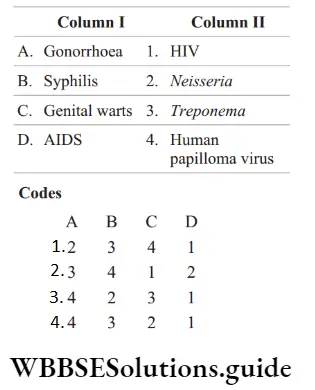
Answer: 1. A–2, B–3, C–4, D–1
Question 21. STDs caused by bacteria is/are
- Syphilis
- Chancroid
- AIDS
- Both 1 and 2
Answer: 4. Bacterial STDs are
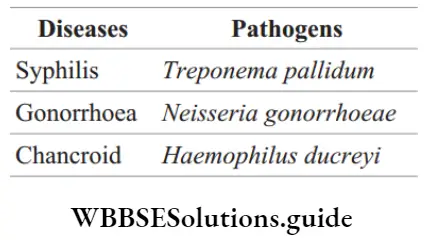
Question 22. Which of the following pairs represents correct pairing?
- Syphilis – Treponema pallidum
- AIDS – Bacillus conjugalis
- Gonorrhoea – Leishmania donovani
- Typhoid – Mycobacterium leprae
Answer: 1. Syphilis – Treponema pallidum
- Option 1 represents correct pairing. Syphilis is bacterial disease caused by a spirochaete bacterium, Treponema pallidum.
- Other options represent incorrect pairings and can be corrected as AIDS is a viral disease caused by Human Immuno Deficiency Virus HIV).
- Gonorrhoea is a sexually transmitted disease and its causative organism is Neisseria gonorrhoeae. Typhoid is an acute infection caused by Gram (– ve) anaerobic flagellated bacillus bacterium, Salmonella typhi.
Biology MCQ For NEET With Answers
Question 23. A sexually transmitted disease symptomised by the development of chancre on the genitals is caused by the infection of
- Treponema pallidum
- Neisseria gonorrhoeae
- Human immunodeficiency virus
- Hepatitis-B virus.
Answer: 1. Treponema pallidum
Syphilis is caused by a spirochaete, Treponema pallidium. It is characterised by the development of chancre at the site of infection, e.g. genitals.
Symptoms and prevention of STIs NEET MCQs with answers
Question 24. Which statement is not correct about syphilis?
- Primary stage of disease shows the appearance of chancre on genitalia and lips
- During latent stage, syphilis, bacteria show severe symptoms and the person is contagious
- Secondary stage of disease shows the appearance of multiple lesions on mucous membrane of lips, mouth and genitalia
- Tertiary stage of disease shows the appearance of gumma on the skin
Answer: 2. During latent stage, syphilis, bacteria show severe symptoms and the person is contagious
- Statement in option 2 is not correct. Syphilis is a bacterial infection usually spread by sexual contact.
- The first stage involves a painless sore on the genitals, rectum or mouth. After the initial sore heals, the second stage is characterised by a rash.
- Then, there are no symptoms until the final stage which may occur years later, it is called the latent stage.
- Patient does not show any symptoms and is not contagious during this phase. The final stage can result in damage to the brain, nerves, eyes or heart.
Question 25. AIDS is Haryana
- Characterised by reduction in number of killer cells
- An autoimmune disease
- Characterised by reduction in number of helper T-cells
- The resist of inability of the body to produce interferon
Answer: 3. Characterised by reduction in number of helper T-cells
During AIDS, the virus replicates inside and kills T-helper cells, which are required for almost all adaptive immune responses. Thus, number of helper T-cells reduces significantly.
NEET Biology Mcq
Question 26. AIDS disease was first reported in
- Russia
- USA
- Germany
- France
Answer: 2. USA
AIDS was first reported in the United State of America (USA) in 1981 and has since became a major worldwide epidemic.
Question 27. The common means of transmission of AIDS is
- Sexual intercourse
- Blood transfusion
- Placental transfer
- All of the above
Answer: 4. All of the above
All given options are common means of transmission of AIDS. HIV (Human Immunodeficiency Virus) causes AIDS (Aquired Immuno Deficiency Syndrome) disease.
The most efficient means of transmission of AIDS is blood transfusion (60%), sexual intercourse (25%) and placental transmission (10%). Thus, option (d) is correct.
Question 28. Which of the following is correct regarding HIV, hepatitis-B, gonorrhoea, trichomoniasis?
- Trichomoniasis is a STD whereas others are not
- Gonorrhoea is a viral disease whereas others are bacterial
- HIV is a pathogen whereas others are diseases
- Hepatitis-B is eradicated completely whereas others are not
Answer: 3. HIV is a pathogen whereas others are diseases
- Option 3 is correct regarding HIV. HIV is a retrovirus that causes AIDS whereas hepatitis-B, gonorrhoea and trichomoniasis are categorised as STDs.
- Other options are incorrect regarding HIV, hepatitis-B, gonorrhoea, trichomoniasis.
- Gonorrhoea is a bacterial disease, hepatitis-B still affects chronically and can only be eradicated with vaccination.
Question 29. Match the name or diseases under the Column 1 with the name or causal organisms given under Column 2.
Choose the correct option from the codes given below.
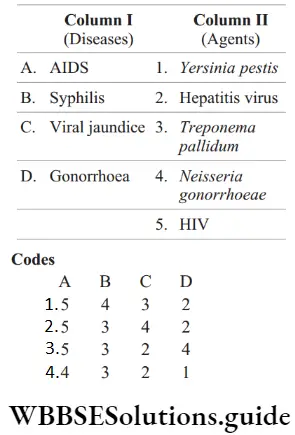
Answer: A–5, B–3, C–2, D–4
Question 30. Detection technique for AIDS is
- PCR
- ELISA
- Both 1 and 2
- Clinical culture
Answer: 3. Both 1 and 2
Generally, AIDS detection is done by ELISA (Enzyme Linked Immuno Sorbent Assay). But sometime the results of this technique are not accurate.
So, by combining it with PCR (Polymerase Chain Reaction), the reliability of the detection of AIDS increases. Thus, option (c) is correct.
NEET Biology Mcq
Question 31. NACO stands for
- National Acid Control Organisation
- National AIDS Comprehending Organisation
- National AIDS Control Organisation
- National AIM for Control Organisation
Answer: 3. National AIDS Control Organisation
NACO stands for National AIDS Control Organisation. It was established in 1992 in India.
Best multiple choice questions on sexually transmitted infections for NEET preparation
Question 32. World AIDS Day and World Earth Day are celebrated on AIDS Day
- 22nd April 1st December
- 2nd December 24th April
- 1st December 22nd April
- 2nd December 24 th April
Answer: 3. 1st December 22nd April
World AIDS Day – 1st December World Earth Day – 22nd April
Question 33. Match the following columns.
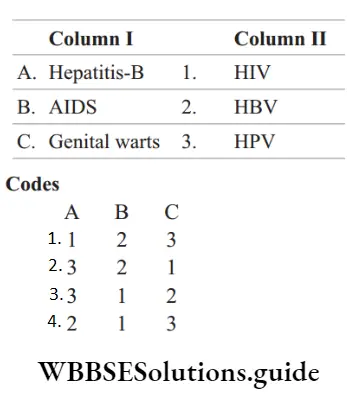
Answer: A–2, B–1, C–3
Question 34. Which of the following STDs are not curable?
- Genital herpes, hepatitis-B, HIV infection
- Chlamydiasis, syphilis, genital warts
- HIV, gonorrhoea, trichomoniasis
- Gonorrhoea, trichomoniasis, hepatitis-B
Answer: 1. Genital herpes, hepatitis-B, HIV infection
Hepatitis-B, genital herpes and HIV infections are not curable. Other sexually transmitted diseases are completely curable, if detected early and treated properly.
NEET Biology Mcq
Question 35. Hepatitis-B and HIV are contacted through
- Sharing used needles
- Transfusion of contaminated blood
- Transfer of infection from infected mother to child
- All of the above
Answer: 4. All of the above
Mode of Infection of AIDS and hepatitis are same. Hepatitis-B and HIV is contacted through sharing used needles, transfusion of contaminated blood and transfer of infection from infected mother to child.
Thus, option 4 is correct.
Question 36. Which of the following diseases is not transmitted through contaminated water?
- Typhoid
- Cholera
- Amoebiasis
- Hepatitis-B
Answer: 4. Hepatitis-B
- Hepatitis-B is caused by hepatitis-B virus which enters the body mainly by sexual contacts and from mother to child.
- It cannot be transmitted through air or water. All the other diseases given in options are transmitted through contaminated water.
Question 37. Hepatitis-B virus is
- Double-stranded DNA virus
- Double-stranded RNA virus
- Single-stranded DNA virus
- Single-stranded RNA virus
Answer: 1. Double-stranded DNA virus
HBV abbreviated Hepatitis-B virus is a partially double-stranded DNA virus. It is a species of the genus Orthohepadnavirus and a member of the Hepadnaviridae family of viruses.
Question 38. Which of the following symptoms are observed in person suffering from hepatitis-B?
- Fatigue and nausea
- Abdominal pain and arthritis
- Jaundice
- All of the above
Answer: 4. All of the above
- All given symptoms are observed in person suffering from hepatitis-B. Person suffering from hepatitis-B has acute illness with symptoms that last for several weeks, including yellowing of the skin and eyes (jaundice), dark urine, extreme fatigue, nausea, vomiting and abdominal pain.
- Sometimes a person with acute hepatitis can develop acute liver failure, which can lead to death.
Thus, option 4 is correct.
NEET Biology Mcq Chapter Wise
Question 39. Which of the following sexually transmitted diseases do not specifically affect reproductive organs?
- Genital warts and hepatitis-B
- Syphilis and genital herpes
- AIDS and hepatitis-B
- Chlamydiasis and AIDS
Answer: 3. AIDS and hepatitis-B
- AIDS and hapatitis-B are sexually transmitted diseases which do not specifically affect reproductive organs.
- AIDS affects the overall immune system of the individual and hepatitis-B affects the liver. These are called STDs because these spread through unsafe or unprotected sex.
Question 40. Hepatitis-B is transmitted through
- Blood transfusion
- Intimate physical contact
- Sexually
- All of the above
Answer: 4. All of the above
Hepatitis-B virus is transmitted through intimate physical contact, blood transfusion and from mother to child. Thus, option (d) is correct.
Question 41. HBSAg test is performed to diagnose
- AIDS
- Herpes
- Hepatitis-B
- Syphilis
Answer: 3. Hepatitis-B
- HBSAg (Hepatitis-B surface antigen A) ‘positive’ or ‘reactive’ test result means that the person is infected with hepatitis-B.
- This test can detect the actual presence of the hepatitis-B virus (called the ‘surface antigen’) in the blood
NEET Biology HIV, AIDS, and other STDs MCQs
Question 42. Which of the following sexually transmitted diseases is not completely curable?
- Gonorrhoea
- Genital warts
- Genital herpes
- Chlamydiasis
Answer: 2. Genital warts
Genital herpes is caused by type-2 herpes simplex virus. At present, there is no cure for type-2 herpes simplex virus. Other non-curable STIs are hepatitis-B and HIV.
Question 43. Recurrence of watery blisters on the genitalia and swollen lymph nodes in groin are the symptoms of
- Genital warts
- Genital herpes
- Genital lesions
- Genital hepatitis
Answer: 2. Genital herpes
- Genital herpes is a Sexually Transmitted Disease (STD).
- This STD causes swollen lymph nodes and herpetic sores, which are painful blisters (fluid-filled bumps) that can break open and ooze fluid.
NEET Biology Mcq Chapter Wise
Question 44. Acyclovir is used in the treatment of
- HIV
- Hepatitis-B
- Genital herpes
- Gonorrhoea
Answer: 3. Genital herpes
Acyclovir is a drug used in the treatment of genital herpes. It inhibits the formation of new sores and interferes with the replication of viruses.
Question 45. Genital warts are caused by
- Human papilloma virus
- Human immunodeficiency virus
- Hepatitis-B virus
- Herpes simplex virus
Answer: 1. Human papilloma virus
- Genital warts are soft growths that appear on the genitals. It is a Sexually Transmitted Infection (STI) caused by certain strains of the Human Papilloma Virus (HPV).
- HPV infection is especially dangerous in women because some types of HPV can cause cancer of the cervix and vulva.
Question 46. Cancer of cervix, vulva, vagina and anus are caused by
- HBV
- HIV
- HSV
- HPV
Answer: 4. HPV
Cervical cancer is caused by sexually acquired infection with certain types of HPV. Two HPV types (16 and 18) cause 70% of cervical cancers and pre-cancerous cervical lesions.
There is also evidence linking HPV with cancers of the anus, vulva, vagina, penis and oropharynx.
- Genital herpes
- Genital warts
- Pubic lice
- AIDS
Answer: 2. Genital warts
Alpha interferons are used in the treatment of genital warts. Other treatments include condylox drug, freezing with liquid nitrogen, laser surgery, etc.
Question 48. Find the correct match.
- Trichomoniasis – Trichomonas vaginalis
- Genital warts – Herpes simplex virus
- Pubic lice – HBV virus
- Vaginal candidiasis – Candida utilis
Answer: 1. Trichomoniasis – Trichomonas vaginalis
- Option (1) is correct match as Trichomonas vaginalis is a protozoan which causes trichomoniasis.
- Other options are incorrect matches and can be corrected as Genital warts are caused by human papilloma virus.
- Pubic lice is infested through sexual activity or through unhygenic way of living. Vaginal candidiasis can be caused by yeast, Candida albicans.
NEET Biology Mcq Chapter Wise
Question 49. Profuse, yellowish, greenish frothy smelling discharge from vagina is due to infection of
- Troponema pallidum
- Chlamydia
- Trichomonas vaginalis
- Neisseria
Answer: 3. Trichomonas vaginalis
- Trichomoniasis is a common sexually transmitted infection caused by a parasite, Trichomonas vaginalis.
- In women, trichomoniasis can cause a foul-smelling vaginal discharge, genital itching and painful urination. Men who have trichomoniasis typically have no symptoms.
Question 50. Which of the following antibiotic is used in the treatment of trichomoniasis?
- Miconazole
- Ceftriaxone
- Aureomycin
- Tetracycline
Answer: 3. Aureomycin
Trichomoniasis is treated using various drugs like aureomycin, terramycin and meteronidazole.
Question 51. Match the following columns.
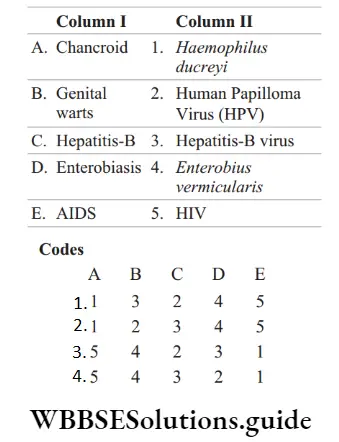
Answer: 2. A–1, B–2, C–3, D– 4, E–5
Question 52. Which one of the following pairs is not correctly matched?
- Syphilis – Treponema
- Sleeping sickness –Trypanosoma Gambiense
- Dengue fever – Arbovirus
- Plague – Entamoeba
Answer: 4. Plague – Entamoeba
Option 4 is not correctly matched pair and can be corrected as Plague is an infectious disease caused by the bacterium, Yersinia pestis and amoebiasis is an infection of the intestines caused by a parasite called Entamoeba.
Question 53. Phthirus pubis causes
- Vaginitis
- Pubic lice
- Syphilis
- Chlamydiasis
Answer: 2. Pubic lice
The most common way to acquire pubic lice is through sexual intercourse. Its causative agent is Phthirus pubis.
Question 54. Untreated chlamydiasis may lead to
- Pelvic Inflammatory Disease (PID)
- Urethra Inflammatory Disease (UID)
- Kidney Inflammatory Disease (KID)
- None of the above
Answer: 1. Pelvic Inflammatory Disease (PID)
- Pelvic Inflammatory Disease (PID) leads to sterility in person suffering from untreated chlamydiasis.
- Other options are explained as Urethra Inflammatory Diseases (UIDs) are caused by bacteria that enter the urethra from the skin around the urethra’s opening. Kidney Inflammatory Disease (KID) is caused by bacterial infection.
Question 55. Transmission of STDs can be prevented by
- Avoiding sex with unknown people
- Having multiple partner
- Following protected sex
- Avoiding sharing of any kind of syringes.
Choose the correct option.
- 1, 2 and 4
- 1, 2 and 3
- 1, 3 and 4
- 1, 2, 3 and 4
Answer: 3. 1, 3 and 4
Transmission of STDs can be prevented by avoiding sex with multiple or unknown partners, using condoms, disposal of syninges after single use, etc. Thus, option (3) is correct.
Question 56. Which of the following is an effective antibiotic for STDs?
- Tetracycline
- Erythromycin
- Rifampicin
- All of these
Answer: 4. All of these
- All given options are effective antibiotics for STDs. Tetracycline is used to treat many different bacterial infections of the skin, intestines, respiratory tract, urinary tract, genitals, lymph nodes, and other body systems.
- It is often used in treating severe acne or sexually transmitted diseases such as syphilis, gonorrhoea or chlamydia.
- Erythromycin is used against against Chlamydia. Rifampin and its analogues are the most active of all antibiotics against Chlamydia trachomatis. Thus, option (d) is correct.
